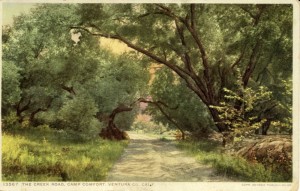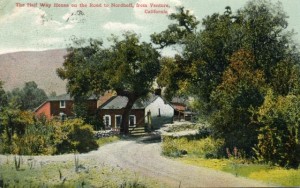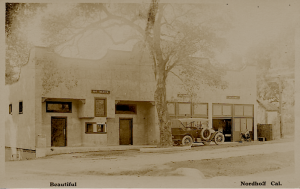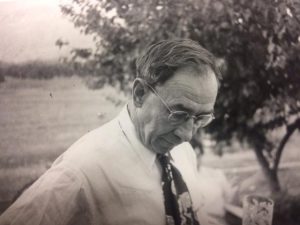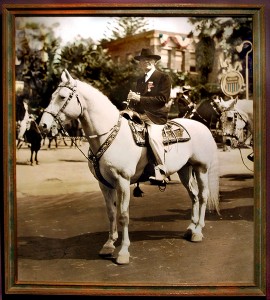The following article first appeared in the Thursday, Sep. 11, 1958 (Vol. 1, No. 35) edition of THE SENTINEL. THE SENTINEL was purchased by the Ojai Valley News. The article is reprinted here with the permission of the Ojai Valley News. The author is Percy G. Watkins.
THE ROAD TO OJAI
by Percy G. Watkins
(continued from last week)
THE ROAD AT THE ARNAZ GRADE
As the road to Nordhoff (Ojai) in 1900 passed La Crosse, (near Casitas Springs), it followed the railroad tracks to pass the home of Ed Goodyear, son of the man who owned part of the Arnaz Ranch at that time.
Here the road split. The Nordhoff Road turned to cross the railroad to go up the San Antonio Creek Valley. The other road went straight up the Ventura River Valley.
After passing the Goodyear home (built like so many of the houses that were here at that time) the traveler passes a large barn which was across highway 399 from the present Rancho Arnaz Cider Mill. West of it, the road wound up to the top of the hill to the farm land of Ed Goodyear (which now belongs to Henry Olivas). Mr. Goodyear was killed on this grade a few years later after being run over by a wagon loaded with corn.
The road then proceed up the Creek past a house which belonged to a man named Amesbury. He was, I think, one of the members of the crew who was drilling the oil well Van Epps managed. This house, and the land which belonged to it was sometimes known as the Harmison Ranch. Alfalfa grew on this land. (It’s now known as the Littlefield Ranch).
The road again leads to Ranch No. 1, with its No. 1 well flowing sulphur water. Beyond the barn and shop stood the house Tom Bard built to house and feed the men associated with him in drilling California’s first drilled oil well.
Across the Creek was the Arnaz School (Oak View’s first school), which was built in 1883 and is still standing. (It is now occupied by the N. Amescua’s). Not far from this point, the road forked and the Creek Road continued on up the San Antonio Creek Valley. And the other one went up the old grade to what is now the central part of Oak View.
At this point was a row of mail boxes which marked the end of the Ventura Star Route. An old fashioned steel-perforated sign indicated the distance to Ventura and to Nordhoff by both routes. A U.S. Geodetic Survey marker stood at this point. (to be continued)

